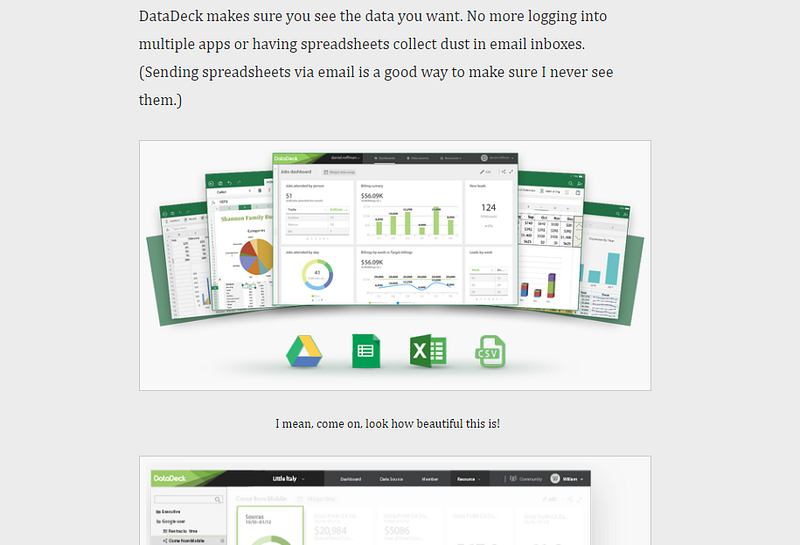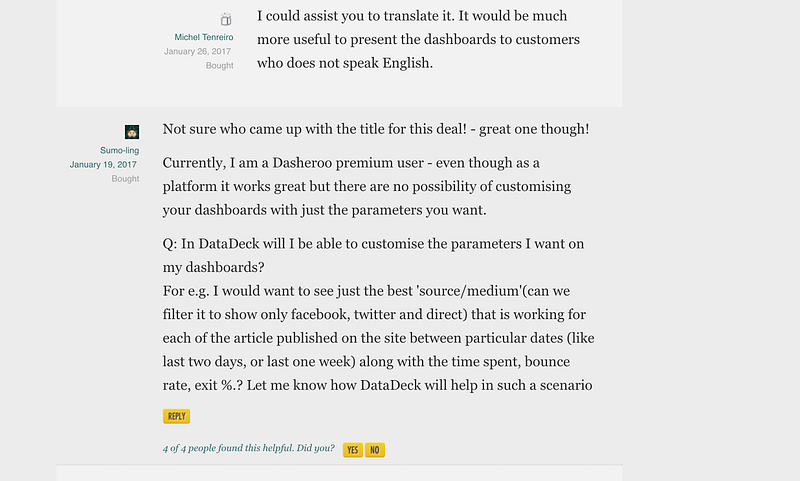Ok, so there are loads of different SaaS products, and many, many ways to skin a cat — but here at DataDeck we are mid-way through an interesting journey towards product success. We want to share with you how we’ve scaled up so far while improving our product along the way. Perhaps some of you could follow the same path…
Like most startups, we wanted quick and easy sign-ups but we were in a crowded market and couldn’t afford ads starring Alec Baldwin… like some people.
Our product — Datadeck — was fresh and ready for its first real users. But what’s the best way to get them without spending a ton of money?
Over recent months our company has set its sights on a global market. We have two territories we hope to conquer: China and the English Speaking world. But these are competitive environments with unique business cultures. No one knows about us so we’re starting from scratch. Technology buyers are wary of us because… well, we’re the new kids.
PHASE 1: How did we fix this New Guy-itis and get our first real users?
We failed a lot at first. It turns out that having a cool idea/product doesn’t mean anything if your marketing channels suck. I guess you already know this, but for what it’s worth we tried forums, we posted on our blog, and reached out to publications — who said they’d help, as long as we paid them thousands of dollars. We backed away slowly, with our hands raised, because we didn’t want to pay $3000 dollars to tech sites with suspect traffic and no guarantees of success.
The advantage of being a software company is that we could give away our product to early users without any heavy overheads. This isn’t a bad idea when in the Beta phase — you’re still working on the product so no one down the line will turn around and say “hey, your product was being given away six months ago!”. Products develop, and it’s reasonable to hike the price when you’ve done your fine-tuning.
We decided to give a small number of users our product, for life, for free. A pretty sweet deal. The hope was that they would say good things about us, and we would get valuable feedback. This was Phase 1.
Product Hunt

We decided to try out the site Product Hunt — a great place for apps and tech products to get their initial kick of users. (It largely revolves around free offerings, but it’s a good way to get some feedback and get people into your product.)
We launched a small campaign and got a little spike in users. We ran a crazy 24-hour/night shift helping our first testers/users get started… and we shared it on Medium too. This allowed us to gather some real feedback from our new market and also introduced us to a mysterious man called Olman…
This was essentially our Phase 1 target complete. We had our initial feedback. We had a check-list of things to be fixed, and we had some users actually in the product, using it, and proving that it had some real value. Nice.
PHASE 2: A Man Called Olman, and scaling up from the Beta version
So, we had our first user spike, we’d learned some things, and impressed some important people. The boss etc. What next?
This is the point when many startups probably begin to fail. They can’t find good ways to reach a wider audience, and don’t manage to convince the public to actually pay for their service. If, however, you really have learned lessons from Phase 1, and your product has shown some genuine promise, you have options…
A successful blip on a site like Product Hunt is a bit like flicking a drop of blood into the sea. It may not be much, and you may be depressed about the small amount of users and your lack of real money flow, but a drop of blood can attract a big shark — ours was called Olman.
AppSumo and Scaling shit up
Olman is a guru over at AppSumo.com. He got in touch after seeing us on Product Hunt and, because we ran a tight ship on that campaign, and really worked hard to make that little channel get our message across, he looked into us. He checked out our product and said that, if we made a few changes, we could be well suited to an AppSumo campaign. We kept this idea on the back-burner for a while, worked on the product, and tried out some different avenues. After a while we decided we were ready to light the fuse on AppSumo. We had to send over a whole bunch of info, work with them on the copy, and put into place certain recommendations. We hired extra customer service help, we psychologically prepared ourselves, and over the space of a month, we worked with Olman as he built up our campaign page…
Interlude & Some details on AppSumo
This site is essentially dope. In a nutshell, they put up great deals on software and apps, and take commission on how many they can sell. They have a massive email list and a great set of copywriters who learn about your product and write up a great pitch, explaining the features, and encouraging sales. You can see some shots of the page they made for us here:



After contacting Appsumo, we were scheduled a date for release — about four months down the line (we still needed to work on the product). They would take a percentage of each sale, and would actively promote us, including emailing their 840,000 subscribers about us…
The Launch
When Launch Day finally came, we had all hands on deck. We’re a smallish team, so a few of us worked around the clock (admittedly I didn’t, but some of the other guys did). When the page launched, and Appsumo emailed their subscribers about us, we were overwhelmed with new users and new problems — we even drafted in help from our Japan and China teams. You can see our increase in support tickets after each Appsumo email being fired off here:

This was the first time Appsumo ever got more sales on their second email than the first (due to further tweaking the copy and general word-of-mouth interest). So many responses were positive 5 out of 5 taco reviews*, praising the product, but a lot of users pointed out kinks too. Some sent us lists of necessary improvements, so we developed an invaluable plan for things we needed to update — and this forms the bulk of our current roadmap for 2017. The positive response was amazing, and we started to see some residual articles appearing about us online. People were finally talking about us…!

The Results : $175,000
All in all, we got 3600+ paid users and a couple hundred people who signed up to our free trial. This was a massive result, even for Appsumo who usually aim for about 1500–2000 sign-ups on whatever app or product they are helping to promote (don’t quote me on this). It was a win-win for us, with almost no risk and it has helped us stress test our product on a whole new level in a new market. Oh, and as these were paid users, that was around $175,000 that we made in around a week. We figure we can now take our portion of that and buy some of those glossy ads we couldn’t afford before.
Maybe we could afford Billy Baldwin?… Hmm.
Anyway, on Product Hunt, our retention rate of users in the product had been low. They were all free users and, with so many deals popping up, they kinda just moved on after a while. As useful as Product Hunt could be, it was interesting to see the difference in retention rate we got between that launch and the Appsumo launch.
Sign-ups


We kept over 32% of our Appsumo users active in the product two weeks after purchase. We consider this a decent amount given the type of product and the nature of this deal. Compared to when we launched on Product Hunt, it seems people are genuinely digging Datadeck.
Residual Income and Cross-selling
One thing we noticed when we launched this campaign was the number of people who looked into our company and were curious about our other products. We had people saying that, if we also offered a deal on our other product Ptengine (a heatmapping tool), they would buy the Appsumo deal on the spot. Or just flat out recommending/hoping that we also offered a Ptengine deal down the line.
Ptengine integrates well with Datadeck, so it made sense for us to then think about creating a deal and mailing all these new users about it a week or two after the campaign. Not every SaaS company will have products that can easily integrate with what they are promoting, but if you do have other products, it is worth thinking about if your brand new, attentive users might be interested in hearing about them.
We created a $25 deal for a 1 year package for Ptengine and offered it to all our Appsumo buyers. We sold over 225 — so that’s $5,625, more interest in one of our products, and something else to brag about around the office. “Look, we’re cross-selling! Take that Japanese team!” It just took an email and a payment form.
The Takeaways
The moral of the story is that you don’t have to pay big bucks to spread word of your product or app, and to get yourself that crucial first wave of active users. If you’re selling SaaS products, you shouldn’t be afraid of giving them away for a dreamy price either — in the beginning. This is a common tactic for products that are still in Beta phase, and as long as you don’t plaster the internet with deals for your product, people will be understanding when you finally get round to charging a reasonable amount.
It can take some effort working up the best possible copy, and it can be good to allow guys who run sites like Appsumo take the lead, as this is their bread-and-butter.
Feel free to get in touch with us if you have any questions about how we pulled this off successfully, or about how we coordinated with Appsumo. We would be happy to advise.
Have you worked with Appsumo or any similar websites? How was your experience? Let us know in the comments below.
*they have a unique reviewing system. Tacos.





